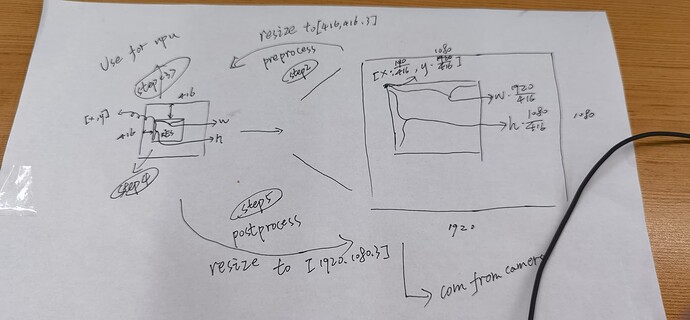@Akkisony I’m not sure why this problem occurs, I haven’t seen it yet, what have you modified, can you provide me with a look?
@Frank Can you please let me know how can I measure the accuracy loss of the model after converting them from darknet to tengine format. Because there is always a loss in accuracy after quantization. I need to know if there is any means where I can measure them? @Frank
@alcohol
Thanks
@Frank Hi, can you please explain briefly how do you calculate the ‘top’ and ‘left’ co-ordinates of the bounding box?
if (cls >= 0)
{
box b = dets[i].bbox;
int left = (b.x - b.w / 2.) * frame.cols;
int top = (b.y - b.h / 2.) * frame.rows;
if (top < 30) {
top = 30;
left +=10;
}
#if DEBUG_OPTION
fprintf(stderr, “left = %d,top = %d\n”, left, top);
Does ‘top’ mean that the co-ordinate of the bounding box is ‘top’ pixels below?
Does ‘left’ mean that the co-ordinate of the bounding box is ‘left’ number of pixels away?
I need this small clarification. Thanks in advance.
- You get a 1920x1080 picture from the camera.
- Resize to 416x416 for NPU reasoning.
- Assuming that an object is recognized, the center point and length and width of the object area will be obtained.
- Next, on the 416x416 picture, through the position and length and width of this area, calculate the upper left corner point and w and h of this area.
- Finally, according to the initial resize ratio, the data on the original picture is calculated, that is, the information drawn on the picture through opencv.
The code here is step 4
@Frank Thank you for the explanation with the diagram. 
I have trained a model to detect a single class using yolov3. The detection seems fine on the CPU, however on the NPU, I have some issues with the non max suppression (as I get 2601 detections on a single image). Can you share your expereince, so it would help me to solve this problem?
These below are the parameter:
const int classes = 1;
const float thresh = 0.5;
const float hier_thresh = 0.5;
const float nms = 0.80;
const int numBBoxes = 5;
const int relative = 1;
const char *coco_names[1] = {“battery”};
float biases[18] = {10, 13, 16, 30, 33, 23, 30, 61, 62, 45, 59, 119, 116, 90, 156, 198, 373, 326};
I even increased the nms value to 0.80, yet, I have the same issue. Please shed some input which can help me to solve the issue! Thanks in advance.
Please find the sample output.
Repeat 1 times, thread 1, avg time 85.24 ms, max_time 85.24 ms, min_time 85.24 ms
num_detections,2601
0: 100%
left = 245,top = 30
0: 100%
left = 253,top = 30
0: 100%
left = 269,top = 30
0: 100%
left = 385,top = 35
0: 100%
left = 102,top = 59
0: 100%
left = -23668,top = 51
0: 100%
left = 110,top = 51
0: 100%
left = -1333402262,top = 58
0: 100%
@Akkisony Many people have reported the problem of the single-category yolo model, so I will make a single-category yolo model this week to see where the problem is
@Akkisony I successfully converted a hand detection model. I will release it this week or next. You can follow the forum or docs at that time.
@Frank Looking forward to the release. I hope now single class detection works using yolov3.
Thank you
@Frank I was working with 1 class yolov3 tengine model.
However, I still did not get an answer what changes I need to make to get my model running. I am facing issue of multiple detections in a single frame (problem on Non max suppression) though my model preforms better on CPU.
@Frank
I mean to say, I have trained a model with single class and I did inference on CPU. I was able to get the detections.
Later, I converted the model to NPU compatible(tengine format) using tengine SDK and now when I do inference, I get the result as explained in my post below.
I get predicitions of 2000+ bouding boxes in a single frame - which is wrong.
@Frank
https://drive.google.com/drive/folders/14wDTO81KBYYfyz0Jj0aWsCXWFixbHpwS?usp=sharing
please find the cfg file.
#batch=1
#subdivisions=1
# Training
batch=64
subdivisions=16
you should use bahtch=1 subdivisions=1
@Frank Thanks. May be I forgot to change the parameter of cfg file while converting using tengine sdk. I will try and update you.
Thanks again!
